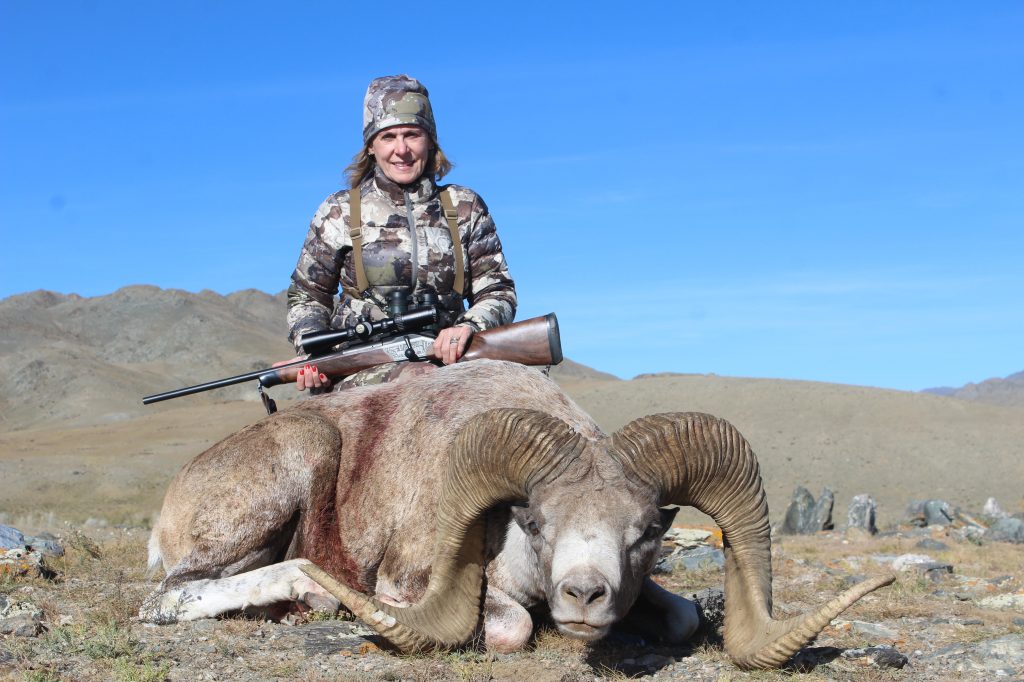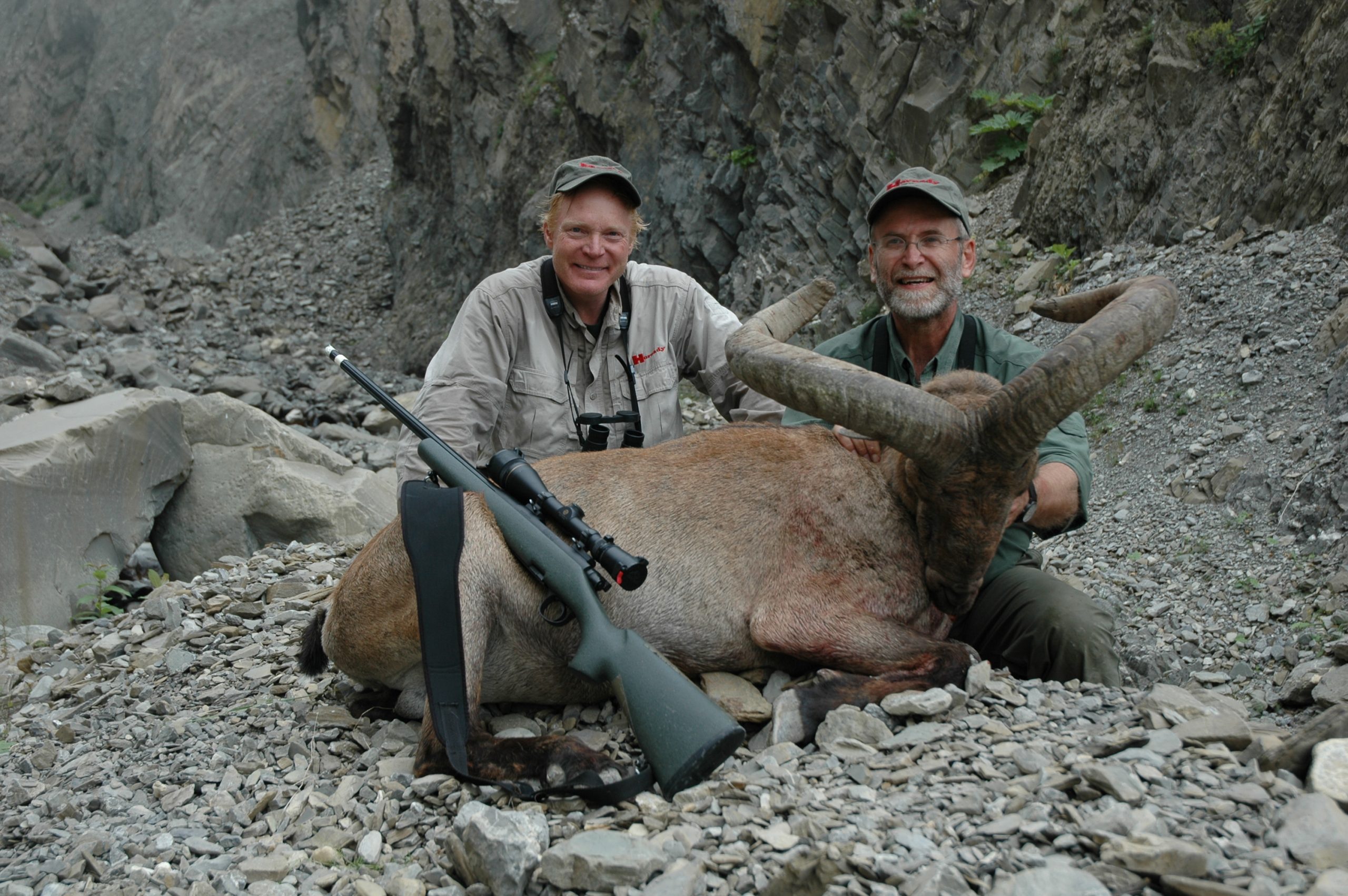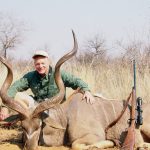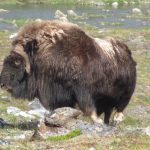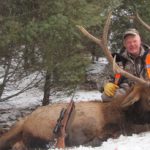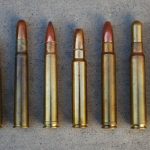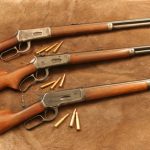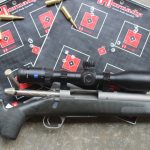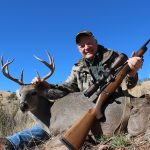The idea that sheep hunts require super long-range cartridges is mostly myth.
Photo above: Boddington and Steve Hornady with a good Dagestan tur, taken with Hornady’s .280 Remington. Hornady has done as much mountain hunting as anyone in the industry, mostly with the .280 Remington.
According to Grand Slam Club Ovis (GSCO), an organization that keeps records on such things, just over 2,100 hunters have taken at least one each of the four North American wild sheep. That’s 8,000 North American wild sheep!
In this group were 75 bowhunters, plus half-dozen muzzleloader hunters. The rest have used an eclectic array of calibers. Experienced sheep hunter George Lawrence III recently took one each of our four North American rams with a .30-30. But my Grand Prize for “most unlikely sheep rifle” goes to Charlie Ren, who guided hunters to desert bighorns in 1930s Sonora. Clients included Grancel Fitz, Frank Hibben, Jack O’Connor, and my uncle, Art Popham. Ren relied solely on his open-sighted 1899 Savage .25-35.
It’s a myth that all sheep and goats are taken at long range. So many rams taken with archery tackle and short-range arms shoot holes in the legend. With a scoped centerfire rifle, nobody plans for a short-range shot, but it happens. Now, if you know your range is limited, you plan your stalk accordingly. There will be rams you cannot approach, so you keep glassing, reading the terrain.
So, I don’t buy that hunting sheep and goats requires long-range shooting. Yep, shots average longer than close-cover whitetails, but not farther than elk, mule deer, or caribou. Thanks to Asian hunting, I have taken a lot of sheep and goats. One thing about mountains: They don’t change much from one range to another. The tall Asian mountains are more open, but you can still stalk. If you can’t, you might have to wait, or seek another opportunity.
I figure my average shot is about 250 yards, much the same for elk, mule deer, and caribou. Sure, there have been “take it or leave it” shots at twice that distance. Many more long shots have been passed. And, there have been very close shots!
I go into a mountain hunt prepared for the worst, hoping for the best. I spend time on the range ensuring my rifle, scope, and load are set up to handle shots at least twice as far as I’m likely to actually shoot. In Mongolia in 2018 we shot six sheep and ibex. Those mountains are big and open, and severe wind complicated some opportunities. Even so, the average shot was less than 250 yards.
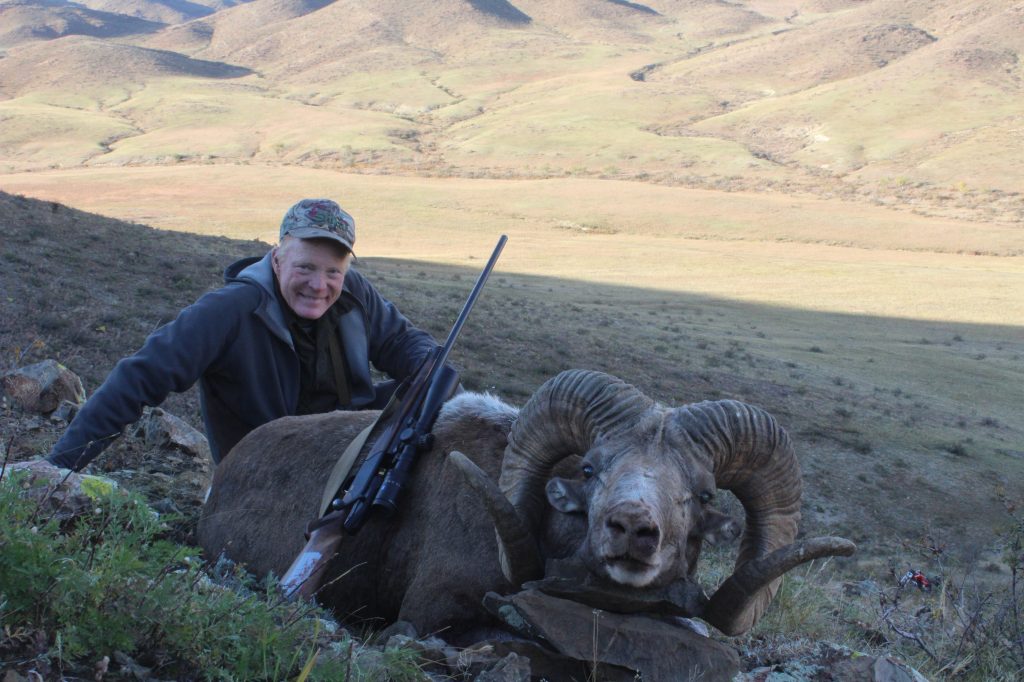
Being ready for the worst instills confidence, and sometimes you need all the capability you have. You bet, I’ve stretched the barrel now and again. Not often, because a cooler head prevails. You realize you can get closer. If not today, maybe tomorrow. Mountain animals move little at night, so leaving them at last light and trying again at dawn is often sound.
I don’t consider sheep or goats “superior game” in any way, but there are practical and psychological considerations. Hunts for most goats are less expensive than most sheep. But, except for resident hunters, there are no “cheap” mountain hunts. Even for residents, drawing a tag may take decades. There’s a lot of pressure, and when the shot comes, you don’t want to blow it. Sensibly, you try to make the shot as certain as possible.
Sure, misses happen. I’m not a good enough liar to say that I’ve never missed! But, although I’ve had plenty unsuccessful mountain hunts, I’ve never had a failure because I missed. So, I’ve passed “possible” shots as too far, or unreadable wind. It’s always best to pass “possible,” wait for “reasonably certain,” and avoid unnecessary chances. If undisturbed, mountain animals are unlikely to leave a mountain system, so there’s strong rationale for biding your time and waiting until a good stalk is possible, rather than risk blowing them out.
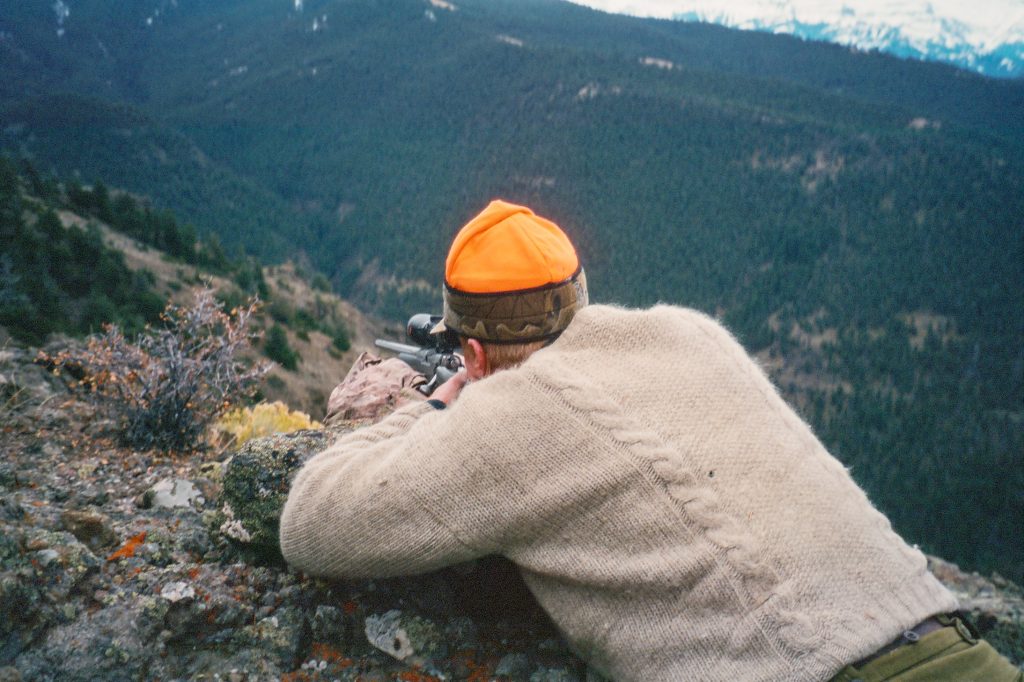
Although their vision is superb, sheep and goats are not as wary as deer. The real trick: You must first conquer the mountain! So, there is an opposite dynamic. Once you get to the top (and the top after that), and are moving into position, you really want to take the shot. Because: You can’t imagine doing it all over again the next day, and you aren’t sure you can! Many shots at sheep and goats come at the end of a long stalk, when you’ve pushed your limits. Many important hunts culminate at the tail end, after successive long days. Better make it good, because, even if there’s a tomorrow, you’re at your limit and there’s no coming back.
This topsy-turvy psychology dictates that you must have absolute confidence in the cartridge you choose and the rifle that launches your bullet. Not all shots are difficult, but there’ s too much at stake. Most experienced mountain hunters settle on one cartridge and rifle that works. It may not be perfect, if there is such a thing, but it’s a comfortable and familiar combination, like Charlie Ren’s .25-35!
In the recent American Hunter, I noted with pleasure that my old friend John Zent, NRA’s Director of Publications, recently completed his four North American wild sheep with a fine desert bighorn. John and I came into the business about the same time, and have been friends for forty years. Few in our industry have had the determination to create and pursue such opportunity; among living gunwriters and their editors, I think just Jim Carmichel, John Zent, and me. So, Zent’s desert ram is a big deal. Their website carried a synopsis, and I was interested to learn that John’s four rams (plus extra), were all taken with the .300 WSM. Nearly twenty years ago, on his first sheep hunt, Zent found his comfort zone and has stuck with it. I have not been so loyal or steadfast.
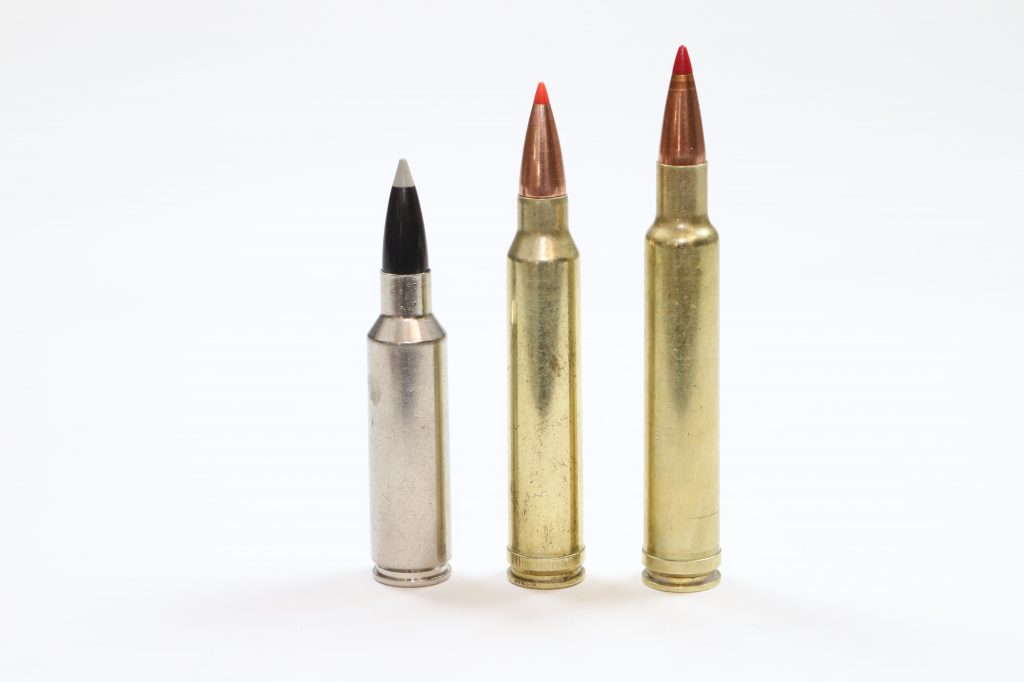
The .300 WSM is a good choice; a recent Weatherby winner also prefers it. I’ve never done any mountain hunting with a .300 WSM, but I have used its fast little brother, the .270 WSM. Often, I default to traditional fast .30-calibers, .300 Winchester and .300 Weatherby Magnum. There are more modern and “better” fast .30s, including the .300 RUM, .30 Nosler, and .300 PRC. For many years, the .300 Weatherby Magnum was a perennial favorite among serious mountain hunters. It still is, but in recent years some have shifted to newer case designs like the RUM and Nosler (which is based on the RUM case shortened). I accept the greater efficiency, but since mountain hunting is first about confidence, I haven’t shifted.
Another thing about sheep and goats: They aren’t much different the world over. In the Old World, chamois are small, and the Asian urial sheep are also small (read: smaller targets, more accuracy). The biggest Asian sheep are larger than ours and some of the Asian ibex and turs are big and blocky, but not significantly larger than a big Rocky Mountain billy or Texas aoudad. No sheep or goat anywhere in the world is as big as an elk, or as tough as a bear. So, in the “pure” world of sheep/goat cartridges, and despite my own frequent choices, I’m not certain .30-caliber power, bullet weight, and recoil are needed.
I want velocity, for downrange energy, wind resistance, and confidence that comes with flat trajectory. There are lots of options. I’ve been happy with faster 6.5mms (read: minimum 140-grain bullet at 3,000 fps). I used the .270 WSM on several mountain hunts, and I’ve used the .270 Weatherby Magnum, both awesome. Winchester’s brand-new 6.8 Western has great promise, not as fast as the WSM, but based on extra-heavy bullets that, until now, no .270 cartridge has enjoyed. That said, I have yet to be on a mountain hunt that the old .270 Winchester couldn’t handle, including the largest-bodied Asian sheep and goats.

Many serious mountain hunters compromise between the 6.5mms and .270s, settling on fast 7mms. My old friend Joe Bishop used a 7mm Remington Magnum for almost all his mountain game; so did Bert Klineburger, who, together with his brothers, pioneered so much Asian mountain hunting. I’ve used various fast 7mms but, as with .270s, “magnum” 7mms are not essential. Jim Carmichel and Steve Hornady did most of their mountain hunting with the .280 Remington, a great choice. If I were to start over, I’d give serious thought to the suddenly popular .280 Ackley Improved, and for sure I’d have a look at the 6.8 Western.
It’s a bit late to start over so, for the mountains that remain to be climbed, I’ll mostly stick with old favorites, .270s and old-fashioned belted .30s. With cartridges (and rifles), familiarity doesn’t breed contempt; it breeds confidence. When you’re on the last ridge and there’s no coming back, you must know your rifle and cartridge can handle the shot you must make, whether close or far.
